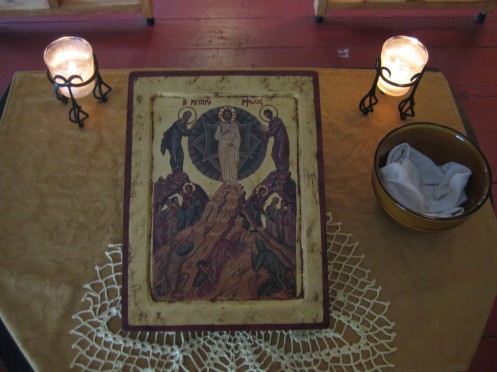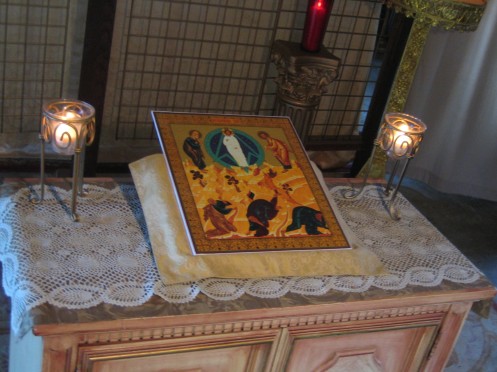Also entitled: THE GROWING DIVIDE BETWEEN THE LINGUISTIC & MATHEMATICAL ARTS
The denial of axioms, those first principles that are either self evident or derived from a higher science, has led to an utter separation of the mathematical arts from the linguistic arts in the general liberal arts to the detriment of both general fields of study. This process began with force with the reformulation of the ancient order of the mathematical arts beginning with the reconsideration of the classical geometry of Euclid. Once the primacy of Euclid was destroyed and geometry seen in a new light of symbolic signs from which new and further abstractions could be gleaned, the mathematical arts further developed which gave rise to the new primacies of the algebras and calculus. Though the new primacies are not necessarily to be lamented in themselves, the preoccupation with the manipulation of numbers, variables, and other symbols abstracted from nearly all intelligible realities has led the mathematical arts into an isolated world with minimal contact and sharing with the world of the linguistic arts.
I. GEOMETRY OVERTHROWN
The classical geometry of Euclid had a multitude of benefits which contributed to its long reign as the basic mathematical art. Firstly, it proceeded from indemonstrable first principles which were (and are) self-evident, and, thus, common to many arts and sciences. Common notions such as “the whole is greater than the part” or “things which are equal to the same thing are also equal to each other”1 were the bedrock principles upon which Euclid’s geometry was based. Secondly, the fundamental geometric realities that were the considerations of classical geometry were and are immediately abstracted from the natural, material world. Thus the concepts of magnitude, square, circle, and triangle, once the varying qualities of matter were left behind, could be considered in their perfections. Thus this conceptual art was eminently intelligible to the intellect as its conceptual realties were immediately abstracted from nature and its proofs were based on arguments that proceeded from self-evident first principles.
While its intelligibility was without question, certain aspects of the classical geometry underwent further development especially in the realm of abstraction. The proofs, although well argued, possessed an inefficiency of expression that could be “streamlined” if further abstractions were performed. Further, with these additional abstractions, alternate considerations could be applied to the signified magnitudes that were not able to be performed previously, viz. arithmetic operations. Many, including the likes of Dr. Otto Bird, assert that René Descartes pioneered this consideration. In Descartes’ work, The Geometry, he asserts:
“Any problem in geometry can be reduced to such terms that a knowledge of the lengths of certain straight lines is sufficient for its construction. Just as arithmetic consists of only four or five operations, namely, addition, subtraction, multiplication, division, and the extraction of roots…so in geometry, to find required lines it is merely necessary to add or subtract other lines.”2
In short, Descartes takes a magnitude and reduces it to a unity which serves to be the measure of other magnitudes. Geometric magnitudes, then, are reduced to numbers. This is done by way of assigning letters to the magnitudes themselves and then performing an arithmetic operation. With this assertion, many claim, came the dawn of analytic geometry and the birth of the Cartesian coordinate system3 and the subordination of geometry to algebra as all geometric realities become a relation of numbers, with numbers themselves as expressed as variables, and not magnitudes, becoming the principle object of consideration. It is for this reason Dr. Bird says:
“Since all the variable letters in our equation represent numbers the geometric line is no longer anything that need be done geometrically; it can be done with numbers. So lines, curves, figures, solids and their relations can all be determined by equations which ultimately are but variable expressions for numbers. Thus Euclid’s Pythagorean Theorem4 proven as a relation between the sides of a triangle, and squares erected on them can now be stated, as we saw, much more simply as A2 + B2 = C2, where at issue is a matter of numbers even though they may also be taken as the lengths of the sides of the triangle. The arithmetical algebraic expression is admittedly more abstract than the corresponding geometric expressions, but it is simpler and easier to work with. Geometry has been arithmetized.”5
In addition to the additional abstraction applied to geometry further removing the signs from the original signification, mathematicians like Descartes established a new precedent by beginning their works not from axioms or any principle from a higher science but from postulates. Granted, Euclid worked from postulates as well, but not exclusively. Rather, he proceeded from postulates stemming from axioms and definitions thus rooting his art and argument in principles that require not blind ascent but common, rational experience. Further, Galileo and Newton also proceeded from axiomatic principles, but their era saw the dawn of arts that posited their own principles that defied scrutiny from other arts and sciences. Other developments in the mathematical arts certainly contributed to the replacement of geometry as the basic mathematical art, but non so much as the first introduction to numeric abstractions and the abandonment of axiomatic principles.
II. MATHEMATICAL STUDIES AFFECTED
With new primacies came new considerations. With old boundaries removed, so went many of the old obstacles. With the advent of variable numeric representation came the reconciliation, or rather the “ever approaching reconciliation”, of that which was formerly believed to be utterly irreconcilable: the curve with the straight and the discreet with the continuous. The efforts of Copernicus, Kepler, Brahe, Galileo, Descartes, Newton, Bonola, etc. allowed for curved realities to be given representation with discreet alphanumeric signification. Naturally, this called the necessity of the traditional mathematical arts as the principle mathematical arts of consideration into question, or, at least, called them into question insofar as how they were considered. Music and astronomy as the principle arts of ratios and mobile magnitudes respectively were replaced by more universal and abstract algebraic understanding of ratios and more universal applications of calculus to mobile beings in general. As stated before, these developments are not necessarily to be lamented insofar as they are productive of more profound knowledge of realities, whether they be concrete or conceptual. But the arts, or, rather, their proponents did not stop there.
Coupled with the abandonment of the scholastic understanding of the universe and its causes, including the disavowal of traditional metaphysics and theology, mathematics took on a new import which it previously did not enjoy and consequently affected its study insofar as its import was concerned. Theology and philosophy were no longer the highest sciences. With the sloughing of the scholastic world-view, the essence of things, natures as such, were no longer the most sought after knowledge for the means to know natures were abandoned. Instead, that which was most knowable to man became the most sublime to him: quantity. As a result, mathematics ascended to primacy among the sciences, a status it enjoys to this day. Let us return again to Descartes and his peers:
“Since the only known natural sciences with some degree of systematic coherence were astronomy and mechanics, and the key to the understanding of mechanics and astronomy was mathematics, mathematics became the most important means to understanding the universe. Moreover, mathematics with its convincing statements was itself the brilliant example that truth could be found in science. The mechanistic philosophy of this period thus came to a conclusion that was similar to that of the Platonists, but for a different reason. Platonists, believing in the harmony of the universe, and Cartesians, believing in a general method based on reason, both found in mathematics the queen of the sciences.”6
This new pedestal upon which mathematics was placed perpetuated infatuations that exacerbated its abstract nature and considerations. Abstractions and their manipulations themselves became the primary concern in many circles resulting in a “science of symbols” where often the symbols themselves were abstracted from any meaning whatsoever. Weber, Frege, and Peano were pioneers in this filed. As bizarre as this may sound its effects were far reaching, the evidence of which can be seen in most high school math textbooks to this day, much to the chagrin and consternation of many a high school student. Struik notes it well:
“…Algebra changed its ancient character. Instead of merely encompassing the theory of algebraic equations and the associated theory of invariants and covariants, it became the abstract doctrine of today with its rings, fields, ideals, and related concepts. One of the origins of the newer algebra was the development of group theory from Galois theory of algebraic equations into an abstract theory in its own right, especially in the theory of finite groups, thus setting a model for the transformation of algebra as a whole.”7
As history has shown, those arts which enjoyed primacy, if not in reality then by popular acclamation, subordinated others arts and often attempted to subsume them to themselves. Advocates of mathematics were no different. The venerable art of logic was the target for this attempted annexation with the most poignant attempts by the likes of Russel, Whitehead, Cantor, and Frege. Logic itself became the target of abstract symbols for its signification with the imposition of symbolic logic with its two subcategories, propositional and predicate. The attempt as noted by both Struik8 and Bird9 ultimately failed but the efforts persisted. The effects are still seen today in texts and graduate institutions that insist upon teaching symbolic logic in their philosophical programs.
III. THE GULF BETWEEN THE TRIVIUM & QUADRIVIUM WIDENED
Mathematics has abandoned the axiomatic system. This was the first and most fundamental break which has led to other divisions between the mathematical and linguistic arts. Without self-evident first principles, how can real knowledge be had? What relation then exists between the linguistic arts which are eminently grounded in reality and an art which seeks not sound and indemonstrable principles? Can mathematics now claim what it once could as expressed in the mouth of Dr. Bird?
“In fact it’s no exaggeration to claim that mathematics has provided the clearest and most explicit instance of reason, of reason itself at work, of reason reasoning, in its development of the axiomatic method. The earliest and most extensive use of this method is to be found in the thirteen books of Euclid’s Elements.
[…]
In denying that there aren’t any self-evident axioms these people are denying that there are any axioms in the old sense as principles distinct from postulates, with the result that the two words have come to be used interchangeably. In any case, an axiomatic system is one that begins from certain indemonstrable principles from which certain other propositions can be deduced as conclusions. “10
Ironically, the attempt to bridge the gap between the linguistic and mathematical arts by attempting a pure mathematics that could be propositionally inferred from earlier principles only served to broaden the chasm between the two general arts. The attempt at reducing logic to a branch of mathematics was intrinsically an attempt at reducing all sciences to the jurisdiction of mathematics –sciences that had concerns over and above that which was quantifiable. As a result, symbolic logic has been relatively ineffectual in the other arts (including philosophy in spite of its persistence) and has only enjoyed any real and lasting effects in mathematical logic. Instead of subsuming logic, mathematics, or rather mathematicians, developed its own language of logic apart from the linguistic arts. But this was not always the case with mathematics and logic. As Dr. Bird points out so well:
“…It is better to retain the old understanding of logic as the study of the principles that assure the validity of inference, and that its laws are those of the laws of the other sciences. Logic is thus the science of sciences, as Aristotle called it, or the art of arts, as Saint Thomas called it.
[…]
Mathematics since the time of its development by the ancient Greeks has always been prized for the power and beauty of its reasoning, and indeed for its ability to form and train the faculty of reasoning itself. As long as Euclid was studied as the basic introductory work to mathematics, Euclid’s geometry provided the basic training for the logic of argument. It provided the basic understanding of what a proof is and the means of constructing and establishing a proof. “11
The former complementarity enjoyed by the trivium and quadrivium through the cooperation of geometry and logic has died. If logic is found to be taught at all in schools, it is done so independent from geometry when this would never have been the case in ancient or medieval education. Hence we have one clear rift between the mathematical and linguistic arts.
Finally, a rift exists between mathematics and reality. Due to the aforementioned obsession with the manipulation of abstractions without any reference to that which is meant to be quantified, mathematics, at least in the general sense of the liberal arts as found in high school and undergraduate institutions, is practically divorced from all reality, concrete or conceptual, since it has become a “science of symbols” meant to arbitrarily signify anything in general or nothing in particular. The ancient considerations of mathematics, whether it was geometry, algebra, or calculus, though abstracted, abstracted from that which was real and considered that which was real. This was true for Euclid’s Elements, Apollonius’s Conic Sections, Ptolemy’s Almagest, Galileo’s Two New Sciences, Descartes’ Geometry, or Newton’s Principia. Now, reference to the real which was once found in the ancient quadrivium can often be more readily found in the more advanced and specialized mathematics proper to certain vocations –not to education in general. The linguistic arts have not suffered this problem; thus the widening between the linguistic and mathematical arts.
BIBLIOGRAPHY
1. Bird, Otto, Ph. D. “The Mathematical Arts of the Quadrivium II”, a lecture given for the International Catholic University and Holy Apostles College & Seminary for the course, “Liberal Arts: Their History & Philosophy”, 2005.
2. Euclid. The Elements of Geometry, Thomas Health (translator), Dover Publications, New York. 1956.
3. Descartes, Rene. The Geometry, David Smith & Marcia Latham (translators), Dover Publications, New York. 1954.
4. Struik, Dirk J. A Concise History of Mathematics, fourth edition, Dover Publications, New York. 1987.
1Euclid. Elements of Geometry, Book I, Common Notions 1 and 5.
2Descartes, René. The Geometry, Book I
3Struik, D. A Concise History of Mathematics, pp. 96-99. Struik points out that many others that preceded Descartes used what could be considered a numeric coordinate system, including the likes of Apollonius of Perga, Ptolemy, and Oresme. Nonetheless, he does not deny that Descartes work was of the greatest influence on coordinate systems and analytic geometry.
4Euclid. Elements of Geometry, Book I, Proposition 47
5Bird, Otto, Ph. D. “The Mathematical Arts of the Quadrivium II”, a lecture given for the International Catholic University and Holy Apostles College & Seminary, 2005.
6Struik, D. A Concise History of Mathematics, Chapter VI, Section 3
7ibid. Chapter IX, Section 6
8ibid. Chapter IX, Section 7
9Bird, Otto, Ph. D. “The Mathematical Arts of the Quadrivium II”
10 ibid.
11 ibid.







